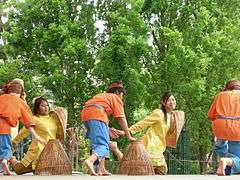Dance in Cambodia
| Part of a series on the |
| Culture of Cambodia |
|---|
 |
| History |
| People |
| Languages |
|
Traditions |
| Cuisine |
|
Festivals |
| Religion |
| Literature |
|
Music and performing arts |
| Sport |
|
Monuments |
|
Dance in Cambodia (Khmer: របាំ robam) consists of three main categories: classical dance of the royal court used for invocation, entertainment and to pay homage, folk dance which portrays cultural traditions, and social dances performed in social gatherings.
Classical dance
Cambodia's premier performing art form is the Khmer classical dance, or Robam Preah Reach Trop, a highly stylized dance form originating from the royal courts. Performances of classical dance consist of elaborately costumed dancers and music played by a pinpeat ensemble. It is performed for invocation of deities and spirits as well as to pay homage to royalty and guests. In the mid-20th century, it was introduced to the general public and became widely celebrated as iconic of Cambodian culture, often being performed during public events, holidays, and for tourists visiting Cambodia. Two of the most performed classical dance are the Robam Chuon Por ("Wishing dance") and the Robam Tep Apsara ("Apsara dance").
Folk Dance
Created in the 20th century are folk dances that emphasize that various cultural traditions and ethnic groups of Cambodia. Cambodian folk dances are usually more fast-paced than classical dances. The movements and gestures are not as stylized as classical dance. Folk dancers wear clothes of the people they are portraying such as Chams, hill tribes, farmers, and peasants. Some folk dances are about love or folktales. Most of the music of folk dances is played by a mahori orchestra.
Selected list of folk dances
- Trot Dance - a popular dance representing a tale of a hunter and a deer who spread several danger between giant to ogress and peacock. It is performed to ward off evil and bad luck.
- Sneak Toseay Dance - a dance around a tiger, a peacock, a deer, and other animals. The dance originates in Phnum Kravanh District, Pursat Province and depicts the Pear people.
- Robam Kom Araek - a dance mainly used two or three bamboo pole which hitting every second. It is reported that the dance came from Kuy people but it is more believed that the birthplace is Philippines during the reign of King Norodom (1834-1904) when he was traveling in Philippines.
- Robam Kngaok Pailin (Pailin peacock dance) - a dance portraying the Kula people in Pailin and their amusement with a pair of peafowl.
- Chhayam - a well known entertainment dance about pleasure, including several comedic roles and beautiful girls. The dance is performed at holidays and is a pure Khmer dance.
Social Dance
In Cambodia, social dances are dances which are danced at social gatherings. Such dances are: Romvong, Romkbach, Saravann, Chok Krapeus and Lam Leav. In addition, other social dances from around the world have affected Cambodian social culture include the Cha-cha, Bolero, and the Madison. Such dances are often performed at Cambodian banquet parties.
See also
- Theatre of Cambodia
- Norodom Buppha Devi
- Dance of Thailand
- Dance of Indonesia
- Balinese dance
- Javanese dance
External links
| Wikimedia Commons has media related to Dance of Cambodia. |
- Archival footage of Dance: The Spirit of Cambodia performing Reamker at Jacob's Pillow in 2001
- Popular Khmer Dances (social activity dances)
- Types of Khmer dance
.jpg)
.jpg)
.jpg)
.jpg)
.jpg)

.jpg)